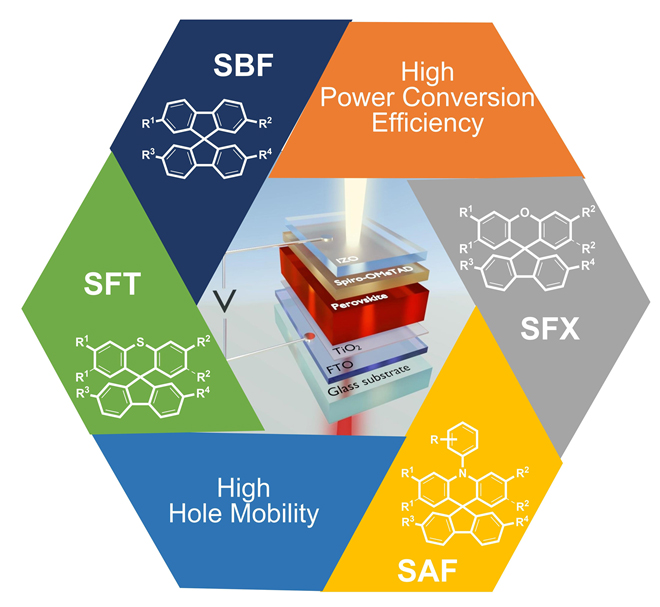摘要/Abstract

近10年, 第三代光电能源转换技术钙钛矿太阳能电池(PSCs)正迅速崛起. 基于有机-无机杂化钙钛矿材料的本征半导体特性以及PSCs平面多层器件架构特点, 采用有机小分子空穴传输材料(HTMs)作为PSCs的p-型层, 不仅实现了PSCs器件的全固态化, 且大幅提升了器件效率及稳定性. 以当前通用的标准空穴传输材料spiro-OMeTAD (2,2′,7,7′-四[N,N-二(4-甲氧基苯基)氨基]-9,9′-螺二芴)为模板, 研究人员开展了众多结构剖析和改进工作. 分子spiro-OMeTAD中, 三维螺二芴(SBF)核能以较小的空间集成更多的空穴传输单元; 而芳胺优异的p-型特性, 使其成为高效的电活性单元. 经典螺芳核SBF制备成本高, 可修饰位置单一; 因此, 基于spiro-OMeTAD的结构改进主要围绕芳胺单元的修饰开展. 随着HTMs分子设计以及合成方法学的进展, 近5年来, 一系列低成本、高性能的类SBF螺芳基单元逐渐兴起, 并迅速进入空穴传输材料领域, 如: 螺[芴-9,9′-氧杂蒽]、螺吖啶、螺硫杂蒽等. 螺芳基核结构的日益丰富, 大大拓展了HTMs分子的设计空间, 从而推动了PSCs效率和稳定性的不断提升. 因此, 本综述聚焦含螺芳烃骨架的HTMs分子, 根据其器件性能表现, 分析高性能材料的结构要素. 按照螺芳烃核结构对高性能HTMs进行分类归纳, 总结了结构设计思路和构效关系. 期望通过较为全面的评述, 为HTMs分子构建提供可参考的策略, 从而推动PSCs继续向高效率、长寿命的实用化方向发展.
关键词: 钙钛矿太阳能电池, 空穴传输材料, 螺环芳烃, 构效关系
The third-generation energy electro-optical technology, perovskite solar cells (PSCs), have risen fast over the past decade. In view of the characteristic of intrinsic-semiconductor of organic-inorganic hybrid perovskite materials, as well as the multilayer planar architecture of PSC devices, the hole transport materials (HTMs) based on organic small molecules were introduced PSCs to make up of p-type layer, by which not only full-solid state PSCs were established, but also the highly efficient and stable PSC devices were attained. Currently, spiro-OMeTAD (2,2′,7,7′-tetrakis[N,N-di(4-methoxy- phenyl)amino]-9,9′-spirobifluorene) is still used as an universal benchmark material in the hole-transporting layer of PSCs, meanwhile the researches have make great effort to analyze and to improve the spiro-OMeTAD. For the prevailing molecule, the three-dimensional core of spirofluorene (SBF) offers a platform to integrate more hole-transporting units with less occupied space, and arylamine groups act as high electroactivity units due to their excellent p-type property. However, the classical SBF core has two major drawbacks: expensive preparation cost and monotonous modification positions, therefore the improvement orientation of spiro-OMeTAD is focused on the arylamine moieties. Along with the developments of molecular design of HTMs and corresponding synthetic methodology, a series of SBF-like aromatic-skeletons have been springing up and stepping into the field of HTMs in recent five years, e.g. spiro[fluorene-9,9′-xanthene], spiroacridine, spirothioxanthene and so on. These advancements expand the design space of HTM molecules, and enhance the efficiency and stability of PSCs. In consequence, we put eyes on the HTMs containing spiro aromatic-skeleton, and seek the structure elements of highly efficient materials. In this review, the high performance HTMs have been classified and summarized according to the type of spiro structure, further, their design solution and structure-performance relationship have also been refined. It is expected that the summarization and condensation would provide valuable strategies for HTMs design and promote the development of highly efficient and long-life PSCs towards practical application.
Key words: perovskite solar cell, hole transport material, spiro aromatic-skeleton, structure-performance relationship
PDF全文下载地址:
点我下载PDF
